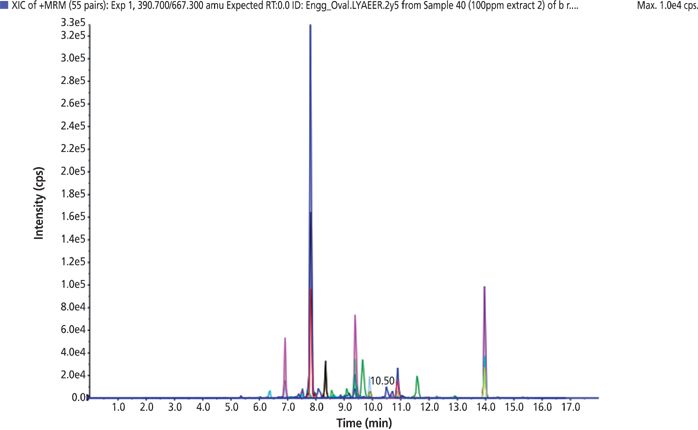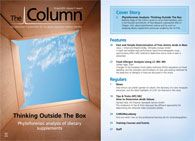Food Allergen Analysis Using LC–MS–MS
Changes to the European Food Safety Authority (EFSA) regulations on food labelling, and the strengths and limitations of new and existing methods for the detection of allergens in food are discussed in this article.
Identifying allergens in food can be difficult and failure to do so can result in the mislabelling of food. Factors responsible include the choice of target analyte, and the effects of food processing and sample matrices. This article reviews changes to the European Food Safety Authority (EFSA) regulations on food labelling, and the strengths and limitations of new and existing methods for the detection of allergens in food.
Approximately 150 million people suffer from food allergies worldwide and this is expected to continue to increase.1,2 Symptoms may include rashes, hives, loss of consciousness, and, in some cases, severe or fatal anaphylaxis. No cure exists for food allergies, and so sufferers have to rely on the correct labelling of foods to avoid allergens.

Photo Credit: Jill Chen/Getty Images
One of the main reasons for food recalls is the detection of allergens.3 For example, a fajita spice mix was recently recalled in the UK which was found to contain undeclared almond protein. Subsequent testing revealed that the paprika in the spice mix was the most likely source of the almond contamination. Food safety agencies in a number of EU nations responded by issuing warnings about products containing paprika (supplied by Santa Maria), for which almond was not included in the allergy advice on the label.4 In the UK, a specially organized workshop was held by the Food Standards Agency (FSA), the British Retail Consortium, the Food and Drink Federation, and the Seasoning and Spice Association to identify potential weaknesses in the herbs and spices supply chain and to discuss what measures need to be taken to protect the consumer.5
New EU Regulations and EFSA Guidelines
In Europe it is mandatory to label certain allergenic ingredients used in foods. In November 2014, the European Food Safety Authority (EFSA) updated its opinions on food labelling as the result of the EFSA Panel on Dietetic Products, Nutrition, and Allergies (NDA) providing their scientific opinion on how allergenic foods and food ingredients are evaluated for labelling purposes.6 Following the updates given by the NDA panel, the Annex IIIa of Directive 2003/89/EC, which includes a list of potentially allergenic food ingredients or substances, was updated.6 New information for each food or ingredient listed in Annex IIIa was included, including the prevalence of the allergy, the dose needed to trigger an adverse reaction in a sensitive individual, cross reactivities, the effects of food processing on the allergenicity of food and ingredients, and the detection of allergens and allergenic foods by different methods. Wider use of labelling and testing for allergens was recommended in the regulations.
New allergy labelling legislation came into effect on 13 December 2014, which requires food businesses to provide allergy information on food that is sold without packaging (in catering outlets, bakeries, and sandwich bars). Other changes relate to the labelling of allergenic ingredients in prepackaged foods.7
Existing Methods for Food Safety Testing and Detection of Allergens
Most commercially available kits for routine food allergen analysis rely on immunological methods such as enzyme-linked immunosorbent assay (ELISA) or on polymerase chain reaction (PCR) approaches.6 ELISA has the advantage of being relatively quick and simple to perform and can be used to detect many known allergens; however, it can only detect one allergen at a time, is susceptible to cross-reactivity, and can lead to the generation of false positive and false negative results. PCR methods are complementary to ELISA methods, and are used to amplify and detect the DNA of an allergen.8 PCR approaches are highly specific, sensitive to very low levels of allergen, and can be used to detect more than two allergens at once. However, the PCR is limited because some food processing methods can destroy detectable DNA, causing false negative results. PCR methods are also highly susceptible to food matrix interferences. In addition, DNA methods are not suitable for the detection of certain allergens, such as egg. There is no DNA in egg white and only one DNA copy in egg yolk.
Liquid chromatography tandem mass spectrometry (LC–MS–MS) is an alternative method for allergen detection that is highly specific, sensitive, and has the ability to directly analyze multiple allergens in a single analysis. LC–MS–MS detection is also not as strongly influenced by food processing, and has the capability for accurate quantitation of the allergens.9 LC–MS–MS allows direct analysis of multiple allergenic proteins in a single preparation; is more sensitive; and allows more accurate quantitation than traditional approaches.
Advances in Food Safety Testing Methods
LC–MS–MS has grown in popularity for allergen testing because it provides quantitative capabilities for multiple allergens simultaneously.
Allergenic proteins are extracted from samples and are subsequently digested into peptide fragments that are directly analyzed using their characteristic molecular masses.10 The analysis of multiple target peptides and their unique masses and fragmentation patterns improves the reliability of allergen detection compared to techniques such as ELISA.
Scientists using LC–MS–MS have to be careful to choose peptides that are unique to the allergen. This is typically done using a BLAST (basic local alignment search tool) search to check the peptide sequence.11
While the sample preparation for LC–MS–MS analysis of allergens might be a bit longer than that for analysis by other techniques, and the upfront investment can be higher than other allergen detection technologies, the benefits that LC–MS–MS can bring to the analysis of allergenic proteins is significant. Figure 1 shows a representative total ion chromatogram for the MRM transitions used for the detection of multiple allergens including peanut, milk, egg, and wheat proteins. In this chromatogram a total of 55 MRM transitions corresponding to 19 unique peptides for the allergens are shown.12

Figure 1: Scheduled MRM screen for peanut, milk, egg, and wheat allergens in a bread sample spiked with 100 ppm milk and egg proteins.
In 2011, EFSA proposed that wines found with casein, caseinate, and milk products may trigger allergic reactions in susceptible individuals. In response, scientists developed a method to accurately detect egg and milk markers in white wine using micro LC–MS–MS. Microflow liquid chromatography can substantially reduce analysis times, and can increase the sensitivity and reduce the use of solvents compared with other MS methods. The method uses a simple sample preparation and complete extraction procedure, followed by dilution and injection; and can provide detection levels below 100 ppb.13
The Future of Food Allergen Analysis
Regulations relating to the methods used for allergen detection and the labelling of foods will continue to be updated and become increasingly stringent around the world. The methods used for food allergen analysis will continue to evolve with the needs of the industry. As the prevalence of food allergy increases and the panel of known allergens grows, new methods will need to be developed to accurately detect these allergens and to determine the minimum levels that are acceptable for a product to be labelled allergen free. LC–MS–MS methods have been shown to have important advantages over other more commonly used techniques for allergen analysis including enhanced sensitivity, reliability, and precision.
References
1. B.I. Nwaru, L. Hickstein, S.S. Panesar, G. Roberts, A. Muraro, and A. Sheikh, Allergy69(8), 992–1007 (2014).
2. Elucidare: Food allergies worldwide, a population review, January 2011. http://www.elucidare.co.uk/assignments/Project_Allergy/Global%20food%20allergies%20statistics.pdf
3. FDA. Finding food allergens where they shouldn't be. 23 October 2014. http://www.fda.gov/ForConsumers/ConsumerUpdates/ucm416577.htm
4. J. Whitworth, Food Quality News. 17 February 2015. http://www.foodqualitynews.com/Industry-news/Santa-Maria-paprika-contaminated-with-nut-proteins
5. http://www.food.gov.uk/news-updates/news/2015/13613/workshop-on-herbs-and-spices-25-february
6. EFSA, EFSA Journal12(11), 3894 (2014). http://www.efsa.europa.eu/en/efsajournal/pub/3894.htm
7. S. Flanagan, New allergen labelling coming to the EU. Food Quality & Safety magazine. June/July 2014.
8. S. Kirsch, S. Fourdrilis, R. Dobson, et al., Analytical and Bioanalytical Chemistry395(1), 57–67 (2009).
9. P.E. Johnson, S. Baumgartner, T. Aldick, et al., Journal of AOAC International 94(4), Special Guest Editor Section 1–8 (2011).
10. L. Bailey, Asia Food Journal 1 February 2014.
11. http://en.wikipedia.org/wiki/BLAST
12. C. Borton, S. Lock, and A. Schreiber, "The use of LC-MS/MS for the analysis of allergens in food," poster presented at North American Chemical Residue Workshop, July 2014.
13. S. Lock, Allergen detection in wine by micro flow liquid chromatography tandem mass spectrometry microLC-MS/MS. Sciex Brochure. http://sciex.com/Documents/brochures/Allergens-in-wine_microLC-QTRAP5500_8880213.pdf
Ashley Sage is currently the senior manager of the European Market Development team at Sciex for the food and environmental business unit. After gaining his PhD in analytical chemistry in separation, mass spectrometry, and spectroscopic science, Ashley moved into the commercial world in 1996 when he joined Micromass as an applications scientist. In this role, he developed mass spectrometry solutions on both quadrupole, triple quad, and time-of-flight instruments for food, pharmaceutical, and life science applications. After seven years, Ashley moved into the business and marketing side of the scientific instrumentation industry and became the global product manager for the time-of-flight MS platform and continued to develop the use of high resolution MS for both life science and applied applications.
E-mail: ashley.sage@sciex.com
Website: www.sciex.com

Analytical Challenges in Measuring Migration from Food Contact Materials
November 2nd 2015Food contact materials contain low molecular weight additives and processing aids which can migrate into foods leading to trace levels of contamination. Food safety is ensured through regulations, comprising compositional controls and migration limits, which present a significant analytical challenge to the food industry to ensure compliance and demonstrate due diligence. Of the various analytical approaches, LC-MS/MS has proved to be an essential tool in monitoring migration of target compounds into foods, and more sophisticated approaches such as LC-high resolution MS (Orbitrap) are being increasingly used for untargeted analysis to monitor non-intentionally added substances. This podcast will provide an overview to this area, illustrated with various applications showing current approaches being employed.
New Method Explored for the Detection of CECs in Crops Irrigated with Contaminated Water
April 30th 2025This new study presents a validated QuEChERS–LC-MS/MS method for detecting eight persistent, mobile, and toxic substances in escarole, tomatoes, and tomato leaves irrigated with contaminated water.
University of Tasmania Researchers Explore Haloacetic Acid Determiniation in Water with capLC–MS
April 29th 2025Haloacetic acid detection has become important when analyzing drinking and swimming pool water. University of Tasmania researchers have begun applying capillary liquid chromatography as a means of detecting these substances.
Prioritizing Non-Target Screening in LC–HRMS Environmental Sample Analysis
April 28th 2025When analyzing samples using liquid chromatography–high-resolution mass spectrometry, there are various ways the processes can be improved. Researchers created new methods for prioritizing these strategies.

.png&w=3840&q=75)

.png&w=3840&q=75)



.png&w=3840&q=75)



.png&w=3840&q=75)











